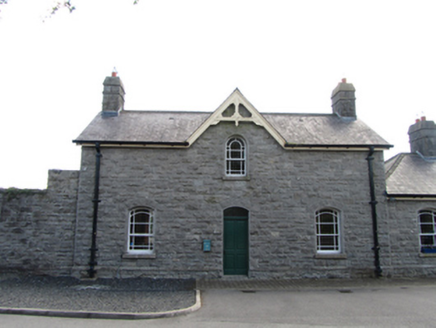Survey Data
Reg No
40307026
Rating
Regional
Categories of Special Interest
Architectural, Social
Original Use
Station master's house
Date
1885 - 1890
Coordinates
236559, 316653
Date Recorded
19/06/2012
Date Updated
--/--/--
Description
Attached three-bay two-storey former station master’s house with gabled centre bay, built 1887, facing former train platform and track to rear, with former railway station attached to west gable. Pitched slate roof with clay roll-moulded ridge tiles, stone chimneystacks over gables having string course and tapered capping. Oversailing eaves and verges having decorative timber trusses to barges on end and front gables, plain barge board to rear gable facing platform and plain fascia boards to eaves. Cast-iron rainwater goods. Snecked random coursed rock-faced ashlar limestone walls over projecting plinth. At first floor round-headed window in central bay to front and rear and segmental-headed window openings to gables, at ground floor segmental-headed window openings in outer bays and smaller paired segmental-headed windows to centre bay to rear, all windows having smooth dressed chamfered arrises and reveals, stone sills and historic timber sash windows, margin panes to all windows apart from smaller pair. Segmental-headed door opening with timber four-panelled door and single-pane overlight. Walled enclosure to of same stonework detail to east. Platform with random rubble stone retaining wall and steps to south.
Appraisal
The former station master's house is a significant part of the railway complex in Belturbet that was built by the Great Northern Railway Company to link with the Great Northern Railway broad gauge. It also linked with the Cavan and Leitrim Railway narrow gauge railway line which served the coal mine at Arigna. Alongside these two adjoining buildings the group now includes an engine shed and goods shed. It is built in the GNR signature round-arched style, and the quality and craftsmanship are typical of the great railway expansion in the nineteenth century. Retaining many historic features, it is a reminder of the high standard domestic accommodation that was provided for railway workers in the past.













